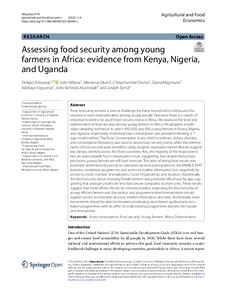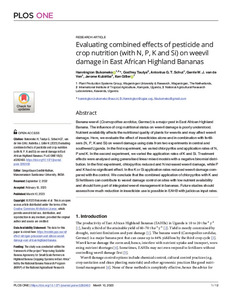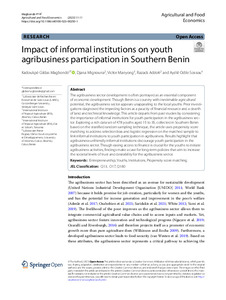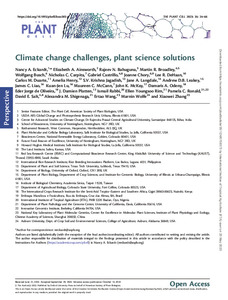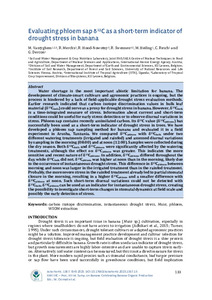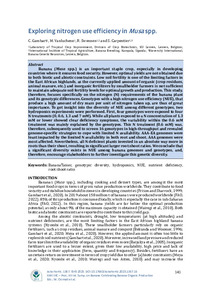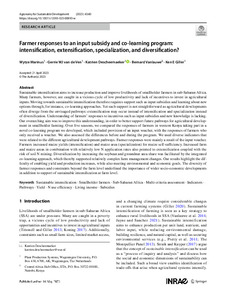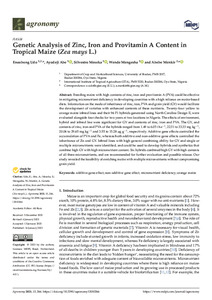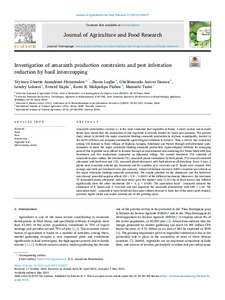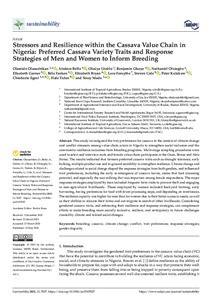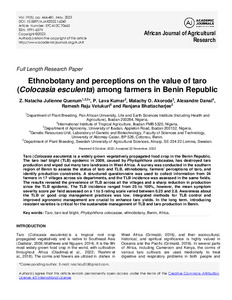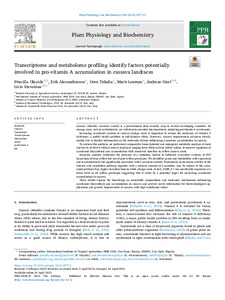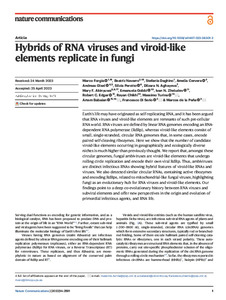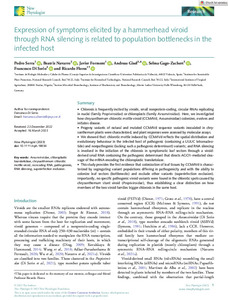Welcome to the International Institute of Tropical Agriculture Research Repository
IITA Bibliography System: Recent submissions
Now showing items 461-480 of 8094
-
Can young agripreneurs improve their skills through agripreneurship empowerment programmes? Evidence from Africa
(2023-01-07)This article examined the driving forces behind young agripreneurs’ participation in agripreneurship empowerment programmes and estimates the causal impact of programme participation on agripreneurship skills using data from a random cross-section sample of 1435 young agripreneurs in Kenya, Nigeria, and Uganda. Specifically, the study took evidence from the youth component of the African Development Bank Technologies for African Agricultural Transformation (TAAT) programme, Empowering Novel ... -
Assessing food security among young farmers in Africa: evidence from Kenya, Nigeria, and Uganda
(2023-02-23)Food insecurity remains a serious challenge for many households in Africa and the situation is even more prevalent among young people. However, there is a dearth of empirical evidence on youth food security status in Africa. We assessed the level and determinants of food security among young farmers in Africa. We adopted a multi-stage sampling technique to select 400, 429, and 606 young farmers in Kenya, Nigeria, and Uganda, respectively. Individual food consumption was assessed following a 7 days ... -
Evaluating combined effects of pesticide and crop nutrition (with N, P, K and Si) on weevil damage in east African highland bananas
(2023-03-10)Banana weevil (Cosmopolites sordidus, Germar) is a major pest in East African Highland Banana. The influence of crop nutritional status on weevil damage is poorly understood. Nutrient availability affects the nutritional quality of plants for weevils and may affect weevil damage. Here, we evaluate the effect of insecticides alone and in combination with fertilisers (N, P, K and Si) on weevil damage using data from two experiments in central and southwest Uganda. In the first experiment, we varied ... -
Impact of informal institutions on youth agribusiness participation in southern Benin
(2023-03-28)The agribusiness sector development is often portrayed as an essential component of economic development. Though Benin is a country with inestimable agricultural potential, the agribusiness sector appears unappealing to the local youths. Prior investigations diagnosed the impeding factors as a paucity of financial resource and a dearth of land and technical knowledge. This article departs from past studies by considering the importance of informal institutions for youth participation in the ... -
Breeding cowpea for adaptation to intercropping for sustainable intensification in the Guinea Savannas of Nigeria
(2023-01)Cowpea is a multifaceted crop; however, considerable challenges affect the production of this crop despite its comparatively better adaptation to harsh environments. Most smallholder farmers in West Africa cultivate this crop in intercropping systems where its low plant population does not allow the full expression of the cultivars’ yield potential. This is because most varieties currently grown in intercrop have been developed in and for monocropping, although some breeding programs recently have ... -
Climate change challenges, plant science solutions
(2023-01)Climate change is a defining challenge of the 21st century, and this decade is a critical time for action to mitigate the worst effects on human populations and ecosystems. Plant science can play an important role in developing crops with enhanced resilience to harsh conditions (e.g. heat, drought, salt stress, flooding, disease outbreaks) and engineering efficient carbon-capturing and carbon-sequestering plants. Here, we present examples of research being conducted in these areas and discuss ... -
Evaluating phloem sap δ13C as a short-term indicator of drought stress in banana
(2023-05)Water shortage is the most important abiotic limitation for banana. The development of climate-smart cultivars and agronomic practices is ongoing, but the process is hindered by a lack of field-applicable drought stress evaluation methods. Earlier research indicated that carbon isotope discrimination values in bulk leaf material (δ13Cbulk) could serve as a proxy for drought stress in banana. However, δ13Cbulk is a time-integrated measure of stress. Information about current and short-term conditions ... -
Exploring nitrogen use efficiency in Musa spp.
(2023-05)Banana (Musa spp.) is an important staple crop, especially in developing countries where it ensures food security. However, optimal yields are not obtained due to both biotic and abiotic constraints. Low soil fertility is one of the limiting factors in the East African highlands, as the currently applied amount of organic (crop residues, animal manure, etc.) and inorganic fertilizers by smallholder farmers is not sufficient to maintain adequate soil fertility levels for optimal growth and production. ... -
Explaining the positioning of agricultural entrepreneurs on the necessity-opportunity continuum in sub-Saharan Africa: insights from Benin
(2023-05)Despite the potential of agriculture to reduce unemployment in sub-Saharan Africa, research on agricultural entrepreneurship is scarce, especially regarding the entrepreneurs’ motivations. The aim of this research is to examine the intensity of necessity and opportunity motivations among agricultural entrepreneurs and the influence of socioeconomic characteristics, personality, and environmental factors. Hence, the study reports a survey of 819 agricultural entrepreneurs in Benin and uses multinomial ... -
Mediation and moderation roles of resilience capacity in the shock–food-security nexus in northern Ghana
(2023-09)This paper examines how resilience capacity mediates or moderates the relationship between weather shocks and household food security based on two waves of farm household survey and satellite-based weather data in northern Ghana and applying econometric models. Results show that resilience capacity moderate or mediates the negative effects of heat stress and drought on food security. However, the mediating role of resilience capacity in the shock-food security nexus is more stable and stronger ... -
Farmer responses to an input subsidy and co‑learning program: intensification, extensification, specialization, and diversification?
(2023-06)Sustainable intensification aims to increase production and improve livelihoods of smallholder farmers in sub-Saharan Africa. Many farmers, however, are caught in a vicious cycle of low productivity and lack of incentives to invest in agricultural inputs. Moving towards sustainable intensification therefore requires support such as input subsidies and learning about new options through, for instance, co-learning approaches. Yet such support is not straightforward as agricultural developments often ... -
Genetic analysis of zinc, iron and provitamin A content in tropical maize (Zea mays L.)
(2023-01)Breeding maize with high contents of zinc, iron and provitamin A (PVA) could be effective in mitigating micronutrient deficiency in developing countries with a high reliance on maize-based diets. Information on the mode of inheritance of zinc, iron, PVA and grain yield (GY) would facilitate the development of varieties with enhanced contents of these nutrients. Twenty-four yellow to orange maize inbred lines and their 96 F1 hybrids generated using North Carolina Design II, were evaluated alongside ... -
Better nitrogen fertilizer management improved Mchare banana productivity and profitability in northern highlands, Tanzania
(2023-05-20)Declining land productivity is a major problem constraining banana (Musa spp.) production in Tanzania. Banana fruit yield consequently reaches only 15% of the potential, primarily due to inadequate soil nutrient replenishment. Improving farmers’ soil nutrient replenishment strategy in banana home gardens, which relies on applications of cattle manure only, by mixing with inorganic fertilizer resources can increase land productivity and can improve the overall profitability of banana production in ... -
Investigation of amaranth production constraints and pest infestation reduction by basil intercropping
(2023-06)Amaranth (Amaranthus cruentus L.) is the most consumed leaf vegetable in Benin. A study carried out in south Benin have shown that the production of this vegetable is severely limited by insect pest pressure. The present study aimed to identify the major constraint limiting amaranth production in Ségbana municipality, located in the north of Benin and proposed sustainable agroecological solutions to farmers. Thus, a survey was conducted among 150 farmers in three villages of Ségbana (Lougou, ... -
Stressors and resilience within the cassava value chain in Nigeria: preferred cassava variety traits and response strategies of men and women to inform breeding
(2023)This study investigated the trait preferences for cassava in the context of climate change and conflict stressors among value-chain actors in Nigeria to strengthen social inclusion and the community-resilience outcomes from breeding programs. Multi-stage sampling procedures were used to select and interview male and female value-chain participants in the Osun, Benue and Abia States. The results indicated that farmers preferred cassava traits such as drought tolerance, early bulking, multiple-product ... -
Ethnobotany and Perceptions on the Value of Taro (Colocasia esculenta) among farmers in the Benin Republic
(2023-05)Taro (Colocasia esculenta) is a widely grown vegetatively propagated food crop in the Benin Republic. The taro leaf blight (TLB) epidemic in 2009, caused by Phytophthora colocasiae, has destroyed taro production and wiped out many taro landraces in West Africa. A survey was conducted in the southern region of Benin to assess the status of taro and TLB, ethnobotany, farmers' perceptions of taro, and identify production constraints. A structured questionnaire was used to collect information from 24 ... -
Transcriptome and metabolome profiling identify factors potentially involved in pro-vitamin A accumulation in cassava landraces
(2023-06)Cassava (Manihot esculenta Crantz) is a predominant food security crop in several developing countries. Its storage roots, rich in carbohydrate, are deficient in essential micronutrients, including provitamin A carotenoids. Increasing carotenoid content in cassava storage roots is important to reduce the incidence of vitamin A deficiency, a public health problem in sub-Saharan Africa. However, cassava improvement advances slowly, mainly due to limited information on the molecular factors influencing ... -
Hybrids of RNA viruses and viroid-like elements replicate in fungi
(2023-05-05)Earth’s lifemay have originated as self-replicating RNA, and it has been argued that RNA viruses and viroid-like elements are remnants of such pre-cellular RNA world. RNA viruses are defined by linear RNA genomes encoding an RNAdependent RNA polymerase (RdRp), whereas viroid-like elements consist of small, single-stranded, circular RNA genomes that, in some cases, encode paired self-cleaving ribozymes. Here we show that the number of candidate viroid-like elements occurring in geographically and ... -
Evaluating the use of nitrogen and phosphorous fertilization as crop management options for maize adaptation to climate change in the Nigeria savannas
(2023-05-04)Poor soil fertility and climate variability are major constraints to maize production in the Nigeria savannas. The application of nitrogen (N) and phosphorus (P) as adaptation strategy may enhance maize yield under climate change. In this study, the already calibrated and validated CERES-maize model in DSSAT was used to simulate the response of maize varieties to N and P in three agroecological zones. Similarly, the model, coupled with data for representative concentration pathways (RCP4.5 and ... -
Expression of symptoms elicited by a hammerhead viroid through RNA silencing is related to population bottlenecks in the infected host
(2023-05-06)Chlorosis is frequently incited by viroids, small nonprotein-coding, circular RNAs replicating in nuclei (family Pospiviroidae) or chloroplasts (family Avsunviroidae). Here, we investigated how chrysanthemum chlorotic mottle viroid (CChMVd, Avsunviroidae) colonizes, evolves and initiates disease. Progeny variants of natural and mutated CChMVd sequence variants inoculated in chrysanthemum plants were characterized, and plant responses were assessed by molecular assays. We showed that: chlorotic ...


